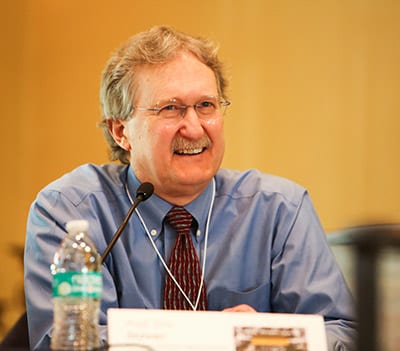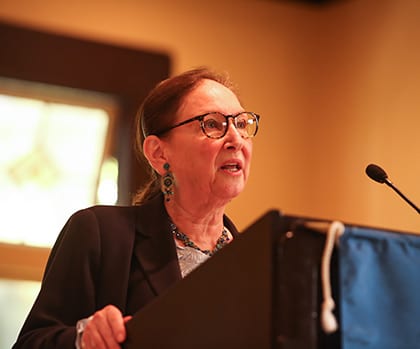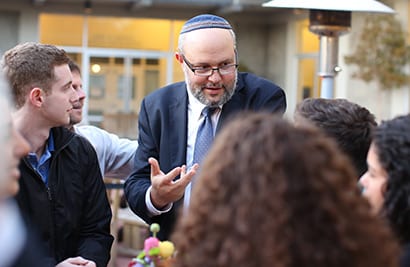
By Andrew Cohen
In the wake of the Holocaust, prosecutors at the 1945 Nuremberg Trials faced a daunting task—trying to seek justice for an unfathomable scale of criminal behavior. Commemorating Nuremberg’s 70th anniversary, a recent Berkeley Law conference shed light on its legacy and influence on subsequent human rights tribunals.
The school’s Berkeley Institute for Jewish Law and Israel Studies and the UC Berkeley Center for Jewish Studies organized the event, which drew more than 200 scholars, students, and other guests. Panelists explored Nuremberg’s role as a watershed moment for international justice after approximately 6 million Jews were killed by the Nazi regime in Germany, and for its indictment of defendants on four counts: crimes against peace, war crimes, crimes against humanity, and conspiracy to commit such crimes.
On one panel, Berkeley Law faculty members Richard Buxbaum ’53 and Eric Stover discussed the roles of victims and perpetrators at Nuremberg and subsequent Holocaust trials with Hanna Yablonka, a professor at Ben-Gurion University of the Negev in Israel.
Probing certain flaws in Nuremberg’s legal structure, Buxbaum, who has conducted extensive research on German reparations after World War II, dissected the prosecution’s difficulty establishing its conspiracy claim. “When did that conspiracy begin?” he said. “In 1933? In 1923 with the occupation of Rhineland? In 1935? The conspiracy allegation swallowed up the substantive counts. The concept of conspiracy itself was an Anglo-American invention, and there were big debates about its reach and aims, which troubled the court.”
The victims’ voice was also sorely lacking, Buxbaum noted, as the trials had “very little individual witness testimony.” In the prosecution’s record of massacres in a sample of 18 Soviet cities, for example, the emphasis was on “general population citizens” with Jewish victims referenced in only one city.

The panel followed a historical path, with Buxbaum analyzing the Nuremberg Trials, Yablonka discussing the 1961 trial of former Nazi leader Adolph Eichmann in Israel after his capture in Argentina, and Stover describing how those events shaped today’s international courts.
Applying Nuremberg’s lessons
Yablonka explained that Nuremberg featured American prosecutors “speaking mostly to the people back home: ‘this is what we fought for.’” By contrast, she said the Eichmann trial “conveyed the Jewish plight.” Unlike the “passive voice” that marked Nuremberg’s records, 110 witnesses testified against Eichmann and the prosecutor declared “I am joined by 6 million prosecutors” in his opening statement.
Yablonka acknowledged that many survivor witnesses had trouble elucidating Germany’s “Final Solution,” its plan to systematically exterminate the Jewish population in Nazi-occupied Europe through genocide. They were “only able to talk about the scope of their individual experience and most had never met Eichmann,” she said.
Still, Yablonka stressed the importance of “survivors not sitting silent. While Nuremberg came at a time when this information was just being made known, in the Eichmann trial this information had been turned into actual knowledge.”
In the 1990s—following the Nuremberg model—the United Nations established special international criminal tribunals to prosecute those responsible for war crimes and genocide in Rwanda and Yugoslavia. In 2003, a permanent International Criminal Court (ICC) was established at The Hague in the Netherlands.
Stover, the faculty director of Berkeley Law’s Human Rights Center, said Nuremberg formed “a bridge to modern-day courts and the human rights challenges they face.” While acknowledging this as a positive overall, he identified stumbling blocks these courts have encountered.

“With the ad hoc tribunals for crimes committed in Rwanda and Yugoslavia, there’s a feeling of disconnectedness because the tribunals themselves (in Tanzania and The Hague) are too far away from where the crimes occurred,” Stover said. “That led to the development of hybrid courts, which emphasize the need to ‘bring trials home.’ ”
The protection of victim witnesses has also faced a bumpy road. “We’ve learned the myth of ‘revealing is healing,’” Stover said. “The witness stand is not a therapy couch, especially when faced with cross-examination.”
While human rights courts have developed better support for victim witnesses in recent years, inefficiency has threatened credibility. “You can already see Western countries that supported the ICC moving away from it because of the time and money it’s taken to resolve cases,” Stover said. “It has also created unfair expectations of reparations for many people.”
Other panels discussed the Nuremberg Trials as legal and historical precedent, and revisited the Holocaust and Nuremberg through a modern-day lens. The conference concluded with a keynote lecture by Justice Rosalie Abella of the Supreme Court of Canada. Abella, whose parents survived the Holocaust, was born in a displaced person’s camp in Stuttgart, Germany in 1946.